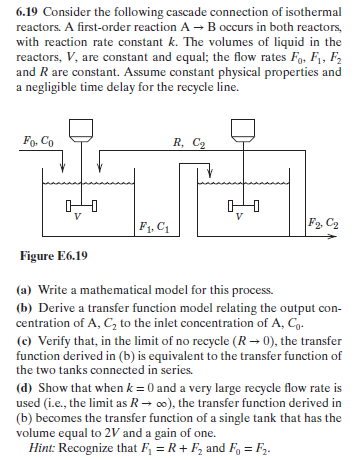6.19 Consider the following cascade connection of isothermal reactors. A first-order reaction A Boccurs in both reactors, with reaction rate constant k. The volumes of liquid in the reactors, V, are constant and equal; the flow rates Fo, Fi, F2 and R are constant. Assume constant physical properties and a negligible time delay for the recycle line. Fo. Co R, C F1, C1 Figure E6.19 (a) Write a mathematical model for this process. (b) Derive a transfer function model relating the output con- centration of A, C2 to the inlet concentration of A, C (c) Verify that, in the limit of no recycle (R-0), the transfer function derived in (b) is equivalent to the transfer function of the two tanks connected in series. (d) Show that when k- 0 and a very large recycle flow rate is used (i.e., the limit as Ro), the transfer function derived in (b) becomes the transfer function of a single tank that has the volume equal to 2V and a gain of one. Hint: Recognize that FRF2 and FoF2
6.19 Consider the following cascade connection of isothermal reactors. A first-order reaction A Boccurs in both reactors, with reaction rate constant k. The volumes of liquid in the reactors, V, are constant and equal; the flow rates Fo, Fi, F2 and R are constant. Assume constant physical properties and a negligible time delay for the recycle line. Fo. Co R, C F1, C1 Figure E6.19 (a) Write a mathematical model for this process. (b) Derive a transfer function model relating the output con- centration of A, C2 to the inlet concentration of A, C (c) Verify that, in the limit of no recycle (R-0), the transfer function derived in (b) is equivalent to the transfer function of the two tanks connected in series. (d) Show that when k- 0 and a very large recycle flow rate is used (i.e., the limit as Ro), the transfer function derived in (b) becomes the transfer function of a single tank that has the volume equal to 2V and a gain of one. Hint: Recognize that FRF2 and FoF2
Introduction to Chemical Engineering Thermodynamics
8th Edition
ISBN:9781259696527
Author:J.M. Smith Termodinamica en ingenieria quimica, Hendrick C Van Ness, Michael Abbott, Mark Swihart
Publisher:J.M. Smith Termodinamica en ingenieria quimica, Hendrick C Van Ness, Michael Abbott, Mark Swihart
Chapter1: Introduction
Section: Chapter Questions
Problem 1.1P
Related questions
Question
PLEASE ANSWER (D) ONLY.

Transcribed Image Text:6.19 Consider the following cascade connection of isothermal
reactors. A first-order reaction A Boccurs in both reactors,
with reaction rate constant k. The volumes of liquid in the
reactors, V, are constant and equal; the flow rates Fo, Fi, F2
and R are constant. Assume constant physical properties and
a negligible time delay for the recycle line.
Fo. Co
R, C
F1, C1
Figure E6.19
(a) Write a mathematical model for this process.
(b) Derive a transfer function model relating the output con-
centration of A, C2 to the inlet concentration of A, C
(c) Verify that, in the limit of no recycle (R-0), the transfer
function derived in (b) is equivalent to the transfer function of
the two tanks connected in series.
(d) Show that when k- 0 and a very large recycle flow rate is
used (i.e., the limit as Ro), the transfer function derived in
(b) becomes the transfer function of a single tank that has the
volume equal to 2V
and a gain of one.
Hint: Recognize that FRF2 and FoF2
Expert Solution
Trending now
This is a popular solution!
Step by step
Solved in 9 steps with 8 images

Knowledge Booster
Learn more about
Need a deep-dive on the concept behind this application? Look no further. Learn more about this topic, chemical-engineering and related others by exploring similar questions and additional content below.Recommended textbooks for you

Introduction to Chemical Engineering Thermodynami…
Chemical Engineering
ISBN:
9781259696527
Author:
J.M. Smith Termodinamica en ingenieria quimica, Hendrick C Van Ness, Michael Abbott, Mark Swihart
Publisher:
McGraw-Hill Education

Elementary Principles of Chemical Processes, Bind…
Chemical Engineering
ISBN:
9781118431221
Author:
Richard M. Felder, Ronald W. Rousseau, Lisa G. Bullard
Publisher:
WILEY

Elements of Chemical Reaction Engineering (5th Ed…
Chemical Engineering
ISBN:
9780133887518
Author:
H. Scott Fogler
Publisher:
Prentice Hall

Introduction to Chemical Engineering Thermodynami…
Chemical Engineering
ISBN:
9781259696527
Author:
J.M. Smith Termodinamica en ingenieria quimica, Hendrick C Van Ness, Michael Abbott, Mark Swihart
Publisher:
McGraw-Hill Education

Elementary Principles of Chemical Processes, Bind…
Chemical Engineering
ISBN:
9781118431221
Author:
Richard M. Felder, Ronald W. Rousseau, Lisa G. Bullard
Publisher:
WILEY

Elements of Chemical Reaction Engineering (5th Ed…
Chemical Engineering
ISBN:
9780133887518
Author:
H. Scott Fogler
Publisher:
Prentice Hall


Industrial Plastics: Theory and Applications
Chemical Engineering
ISBN:
9781285061238
Author:
Lokensgard, Erik
Publisher:
Delmar Cengage Learning

Unit Operations of Chemical Engineering
Chemical Engineering
ISBN:
9780072848236
Author:
Warren McCabe, Julian C. Smith, Peter Harriott
Publisher:
McGraw-Hill Companies, The